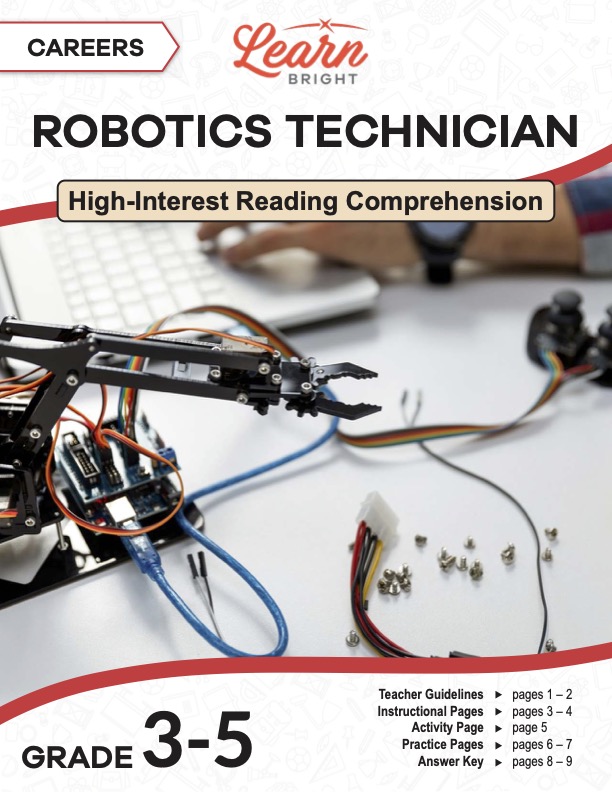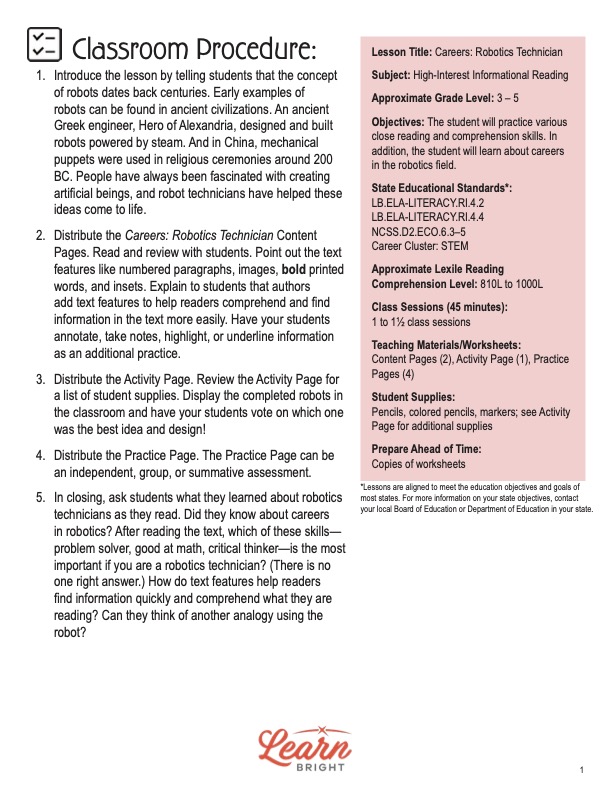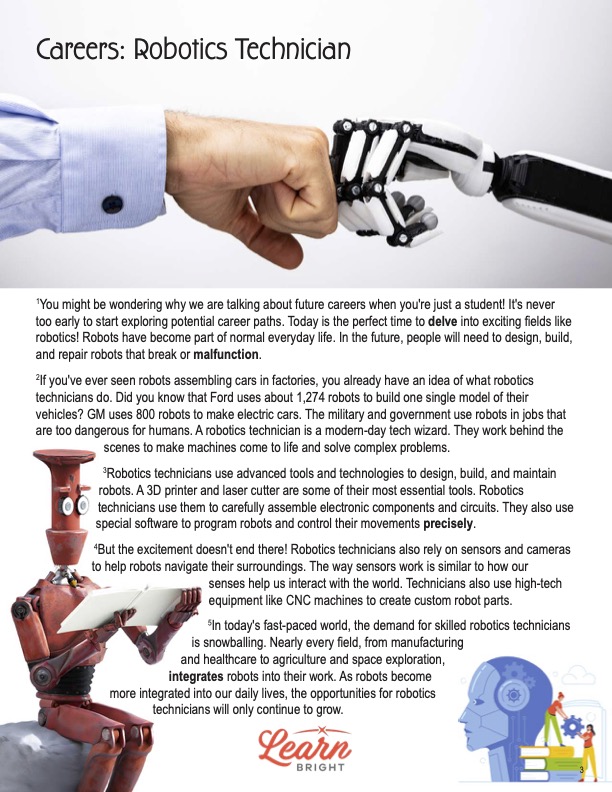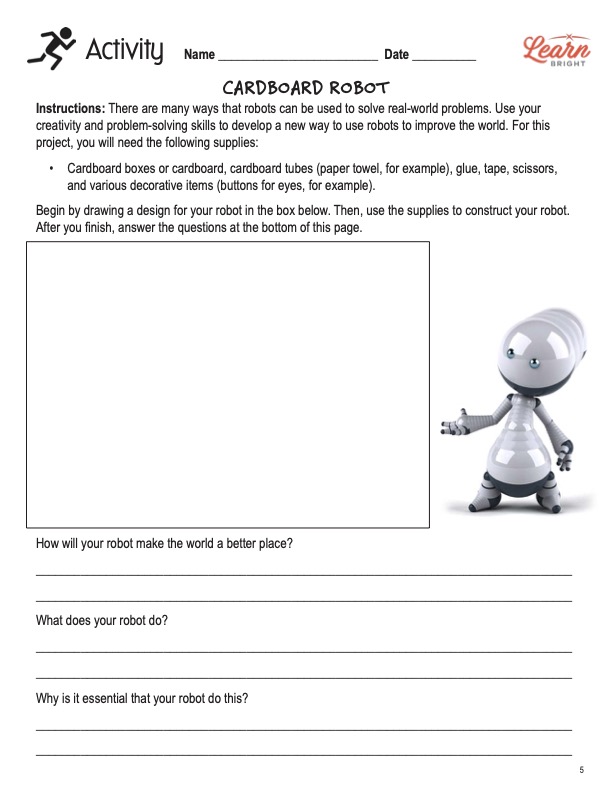Description
What our Careers: Robotics Technician lesson plan includes
Lesson Objectives and Overview: Careers: Robotics Technician is a high-interest reading comprehension lesson plan. As such, students will practice various close reading and comprehension skills. In addition, they will learn about the technician field of robotics. This lesson is for students in 3rd grade, 4th grade, and 5th grade.
Classroom Procedure
Every lesson plan provides you with a classroom procedure page that outlines a step-by-step guide to follow. You do not have to follow the guide exactly. The guide helps you organize the lesson and details when to hand out worksheets. It also lists information in the yellow box that you might find useful. You will find the lesson objectives, state standards, and number of class sessions the lesson should take to complete in this area. In addition, it describes the supplies you will need as well as what and how you need to prepare beforehand. Check the Activity Page for a list of supplies you will need in addition to pencils, colored pencils, and markers.
Teacher Notes
The paragraph on this page gives you a little more information on the lesson overall and describes what you may want to focus your teaching on. It explains that you can teach this lesson in a whole-class setting or as an independent, small-group activity. The blank lines are available for you to write out any thoughts or ideas you have as you prepare.
CAREERS: ROBOTICS TECHNICIAN LESSON PLAN CONTENT PAGES
The Career of a Robotics Technician
The Careers: Robotics Technician lesson plan contains two content pages. You might be wondering why we are talking about future careers when you’re just a student! It’s never too early to start exploring potential career paths. Today is the perfect time to delve into exciting fields like robotics! Robots have become part of normal everyday life. In the future, people will need to design, build, and repair robots that break or malfunction.
If you’ve ever seen robots assembling cars in factories, you already have an idea of what robotics technicians do. Did you know that Ford uses about 1,274 robots to build one single model of their vehicles? GM uses 800 robots to make electric cars. The military and government use robots in jobs that are too dangerous for humans. A robotics technician is a modern-day tech wizard. They work behind the scenes to make machines come to life and solve complex problems.
What They Do
Robotics technicians use advanced tools and technologies to design, build, and maintain robots. A 3D printer and laser cutter are some of their most essential tools. Robotics technicians use them to carefully assemble electronic components and circuits. They also use special software to program robots and control their movements precisely.
But the excitement doesn’t end there! Robotics technicians also rely on sensors and cameras to help robots navigate their surroundings. The way sensors work is similar to how our senses help us interact with the world. Technicians also use high-tech equipment like CNC machines to create custom robot parts.
In today’s fast-paced world, the demand for skilled robotics technicians is snowballing. Nearly every field, from manufacturing and healthcare to agriculture and space exploration, integrates robots into their work. As robots become more integrated into our daily lives, the opportunities for robotics technicians will only continue to grow.
What to Expect
What does this mean for you? For starters, pursuing a career as a robotics technician can lead to exciting opportunities. You will have the chance to shape the future of technology. A robotics technician works with robots to make them work better and last longer. They fix problems, test how well robots work, and ensure they do their jobs right.
For example, they might adjust a robot that puts things together in a factory so it does its job faster and more accurately. In hospitals, they might help keep surgical robots working correctly to help doctors during operations. On farms, they work on machines that pick crops without harming the environment. These tasks make things work better. By working with robots, technicians help make the world a better place for everyone.
Becoming a Robotics Technician
What does it take to become a robotics technician? It begins with a passion for technology, a curiosity about how things work, and a willingness to learn and adapt. While a high school diploma is the minimum requirement, most robotics technicians hold a bachelor’s degree in robotics, electrical engineering, or a related field. Additionally, many pursue advanced degrees or certifications to specialize in specific areas of robotics, such as mechatronics or computer vision. You must like math, be a critical thinker, and be a problem solver.
In addition to formal education, robotics technicians gain practical experience through internships, cooperative education programs, and hands-on projects. Hands-on training is essential for developing the skills and expertise needed to excel in robotics. According to the US Bureau of Labor Statistics, most robotics technicians make around $60,000 annually, and salaries are on the rise!
A career in robotics offers a unique mix of creativity, innovation, and problem
solving. So, if you’re passionate about technology and intrigued by the possibilities
of robotics, consider becoming a robotics technician. You just might invent the next revolutionary robot or help solve some of the world’s most pressing challenges with your skills and expertise!
CAREERS: ROBOTICS TECHNICIAN LESSON PLAN WORKSHEETS
The Careers: Robotics Technician lesson plan includes two worksheets: an activity worksheet and a practice worksheet. Each one will help students solidify their grasp of the material they learned throughout the lesson. You can refer to the classroom procedure guidelines to know when to hand out each worksheet.
CARDBOARD ROBOT ACTIVITY WORKSHEET
For the activity, students will design and build robots using cardboard and other supplies. They must first think of a new way to use robots to improve the world. Then they will draw a picture of the robot in the box on the worksheet page. Finally, they will answer the questions at the bottom of the page that relate to how their robot will help make the world a better place.
PRACTICE WORKSHEET
The practice worksheet requires students to answer a series of 10 questions. These questions all relate to the content pages, so students will need to refer to them often for the answers. In addition, each question provides which reading tool the question corresponds to, such as text feature, vocabulary, or comprehension.
Worksheet Answer Keys
At the end of the lesson plan document is an answer key for the practice worksheet. The correct answers are all in red to make it easier for you to compare them with students’ responses. If you choose to administer the lesson pages to your students via PDF, you will need to save a new file that omits these pages. Otherwise, you can simply print out the applicable pages and keep these as reference for yourself when grading assignments.









